Confession: I’ve been Tree Blind
Recently, I read a New York Times article by Gabriel Popkin that opened my eyes (figuratively and literally) about tree blindness. Do not fret! This affliction is curable. Up until this point, I have usually passed by trees and thought, “wow, a tree,” and nothing more. Little did I know that they are so much more diverse and complicated that I ever could have imagined.
As I mentioned in my bio, I have come to adore the animals and pollinating insects that surround us. They cannot afford to be tree blind. How could they know which fruit is edible, which branches make good nests, which what needs pollinated if they remained blind to the world of trees. There was a time when all humans had to be just as knowledgeable, according to Popkin.
To combat my tree blindness, I took a walk through the river floodplains of the Olentangy River and the areas surrounding the bike trail. The following tree identification and information comes from my handy-dandy Field Guide to Trees and Shrubs by George Petrides that accompanied me along the way. Come with me on my journey to identify some species of trees in Ohio and explore just how fascinating and different trees can be. Maybe one day I will have as good of tree-sight as the animals and insects around us. This is at least a start.
Black Cherry
(Prunus serotina)
I found this beauty while walking along the bike trail of the Olentangy River in the midst of the wooded floodplains. Although this tree could be identified using its alternately arranged and simple leaves, what really caught my attention was the distinctive bark. The older black cherry tree bark looks very scaly with its edges peeling away from the tree. The bark is very dark, but can appear red underneath the cracks according to the field guide.
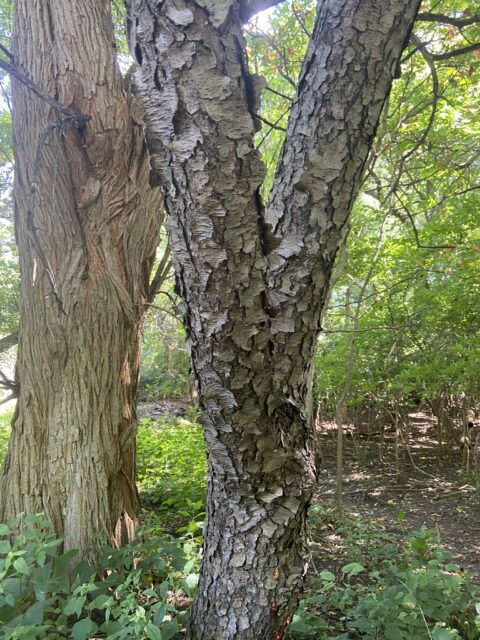
Notice the dark, scaliness of the black cherry’s bark. Wouldn’t that catch your eye, too!
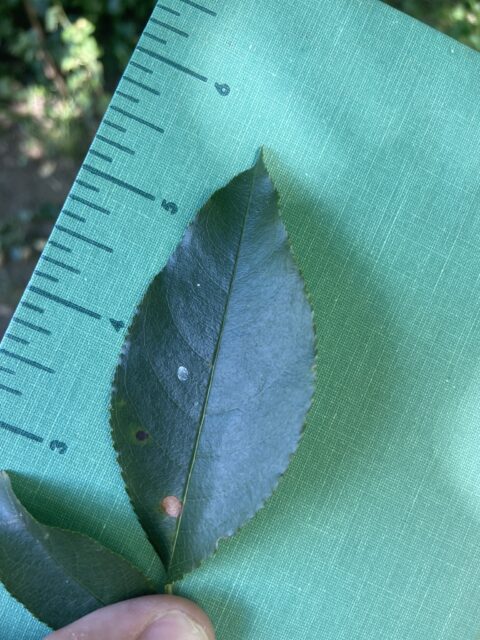
The simple leaf has serrated margins. Not pictured is the hairy midrib of the leaf underside because my phone camera could not focus on that magnificent feature of the leaf.
This tree provides many benefits to both people and animals. Petrides says that the wood makes good furniture, the cherries make a bitter jam, and the bark is used as flavoring! These fruits are also the delicious snacks of many birds, raccoons, squirrels, and more! Just like Popkin pointed out–there’s free food we’re completely ignoring!
Catawba Tree (Northern Catalpa)
(Catalpa speciosa)
When I say this tree smacked me in the face, I mean it. It almost completely cured my tree blindness right then and there. The mere size of these heart-shaped leaves was truly a sight to see. This tree has opposite (sometimes whorled), simple leaves that are basically the size of my face. There are a few species within this genera, but the non-odorous characteristic of its leaves led me to identify this tree as the catawaba tree rather than its odorous counterpart, the common catalpa (Catalpa bignonioides).
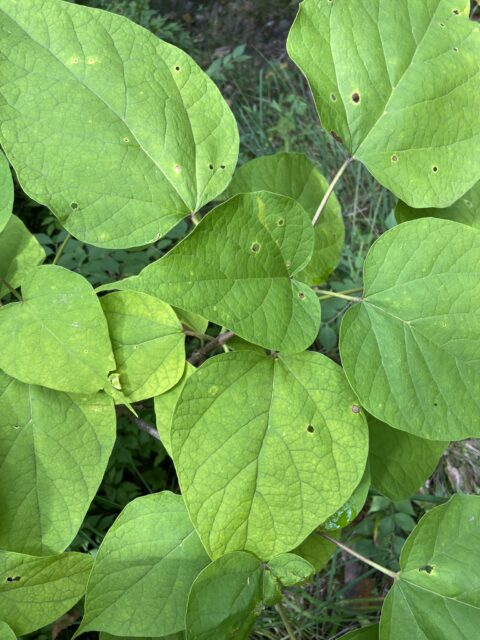
Be-leaf it or not, some of these leaves were bigger than the palm of my hand! Notice their distinctive heart shape.
This tree is often referred to as having “cigar-shaped fruits,” according to my field guide. It’s true! Their long, bean-like fruits can even grow up to 18″ in length (Virginia Tech Dendrology)!
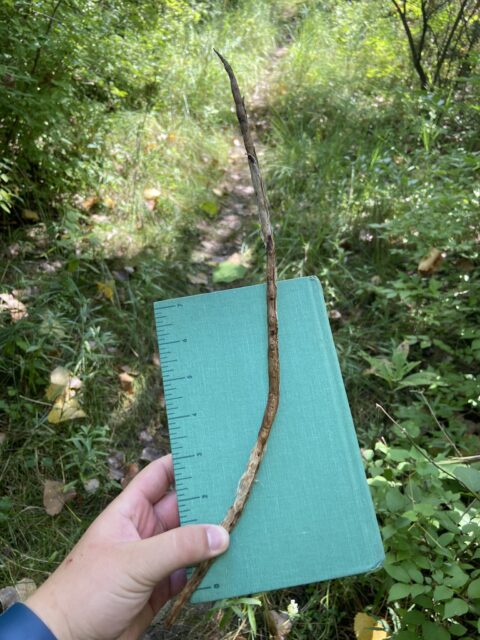
Pictured is a dried up fruit from the Catawba Tree. Just look at how long that is!
Petrides also informed me that these trees attract “catawba worms,” which are a caterpillar useful for fishing bait.
Common Cottonwood (Eastern Cottonwood)
(Populus deltoides)
This next tree I found along the edges of the river and up the floodplains. It is the mighty common cottonwood. Why is this tree so mighty, you may ask…well the gigantic size of the adult trunks surely warrants the description with their dark color and deep ridges. I also identified this tree based on its simple and toothed triangular leaves which alternate along the twigs. My field guide said this member of the poplars likes rich soils, which makes sense that I found it along the river. Another distinctive feature of this tree is the flattened ends of the leaf stalks, which make the leaves sound like rustling paper in the wind.
Because of its massive size and ability to grow rapidly, the common cottonwood is often a great tree for windbreaks along marshes and rivers. It can provide shade to people or shelter for animals (Cottonwood Tree Facts: Gardening Know How).
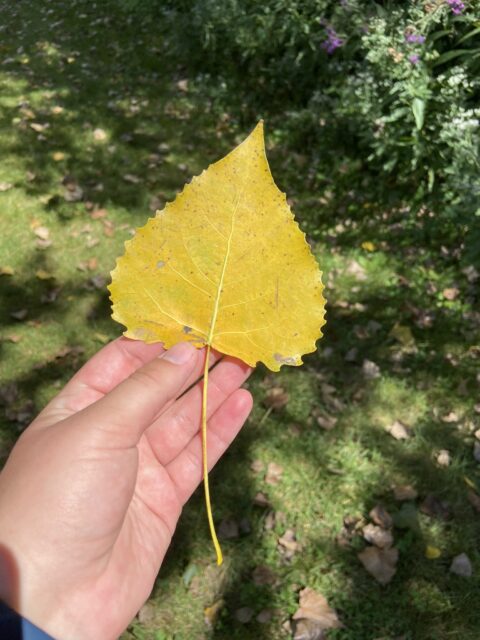
Because the cottonwoods I found were all massive, the best leaf picture I could get came from ones that had dropped. Here you can see the deltoid shape and flat leaf stalk.
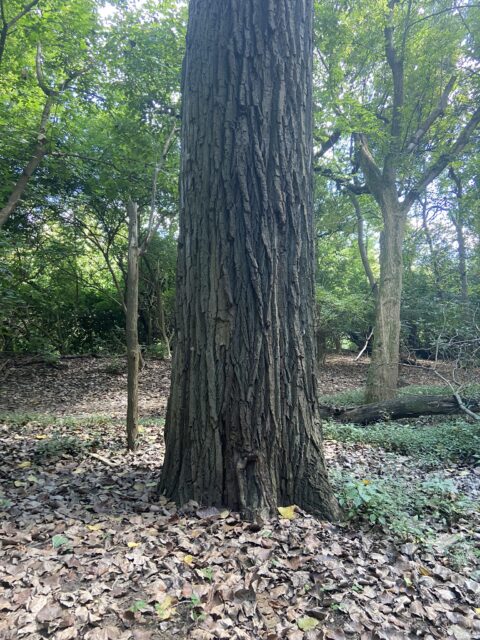
Look at the size of that trunk! See its dark and deep ridges?
American Hackberry
(Celtis occidentalis)
Considering my field guide said these trees were found in woods, its no surprise that I found these trees spread all across the wooded areas along the Olentangy Bike Trail. These trees have simple, alternately arranged leaves with some other interesting characteristics. The leaves are rough on the surface and the bases are uneven (as if someone hacked off one side…get it?).
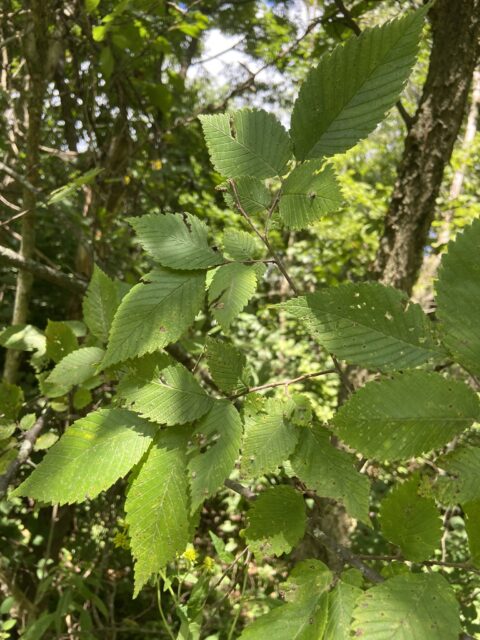
Pictured are the coarsely toothed, uneven leaves of the hackberry.
Now I don’t know about you, but when I hear “hackberry” I imagine an odd-looking creature. In my opinion…I wasn’t that far off. Looking at the bark of the mature hackberry trees, I noticed the bark had knob-like ridges that appeared wart-like. And what do you know–that’s is just how Petrides described it. When I used to think of tree bark, I just imagined a brown surface with nothing notable about it. But lo and behold, twas just my tree blindness. Luckily the weirdness of the hackberry is helping to cure it.
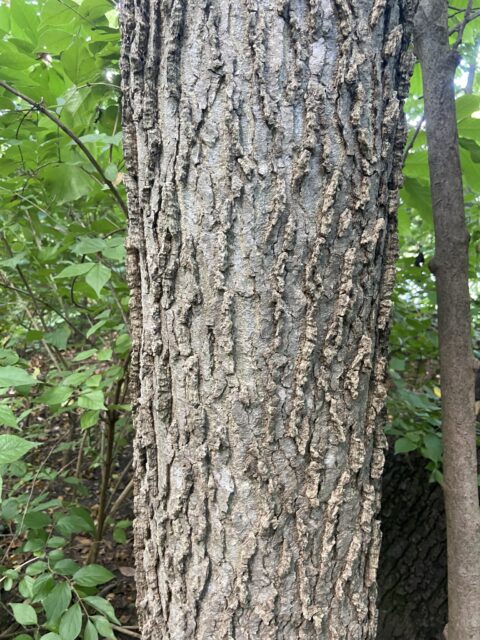
The warty bark of a hackberry. What a unique texture!
The fruits of the hackberry are sometimes called “sugarberries.” Doesn’t that sound yummy? Well if you think it does, the game birds that eat them would probably agree with you. According to blogger Forager Chef, the hackberry tastes a bit like squash and date with the texture of a nut.
Honey Locust
(Gleditsia triacanthos)
In the woods up along the bike trail, I found this tree which I think is aptly named. Let me explain: when I think of “honey”, I picture something sweet and beautiful. When I think of the word “locust,” I imagine the pesky insects that cause destruction and damage. Okay, so what does this have to do with this tree? First, the tree has beautiful pinnately compound leaves that are arranged alternately along the branch. Each leaf has many little leaflets, and are actually twice-compound on some twigs. But don’t let this beauty fool you. Along the twigs, the honey locust has several-inch long thorns that almost literally blinded me as I tried to closely examine the tree. I distinguished this from the black locust species because it thorns were unpaired.
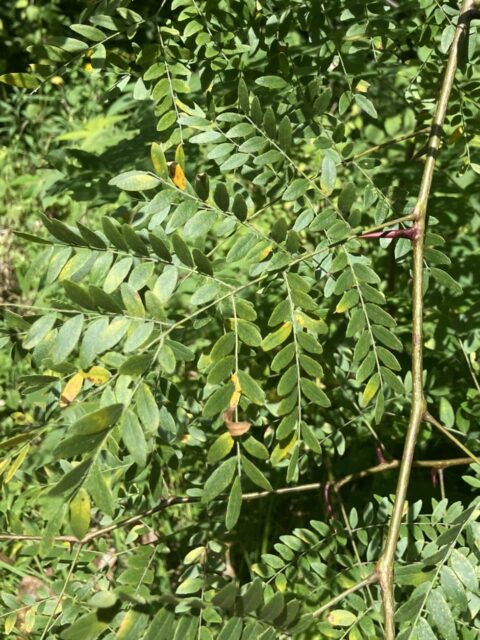
Here you can see the twice-pinnate compound leaves with one of the infamous thorns near the leaf base.
The fruits of the honey locusts are pretty interesting, too. They can grow up to 18″ in length and twist around themselves. This differentiates them from the swamp locust whose fruits only grow to about 2″ in length (Petrides).
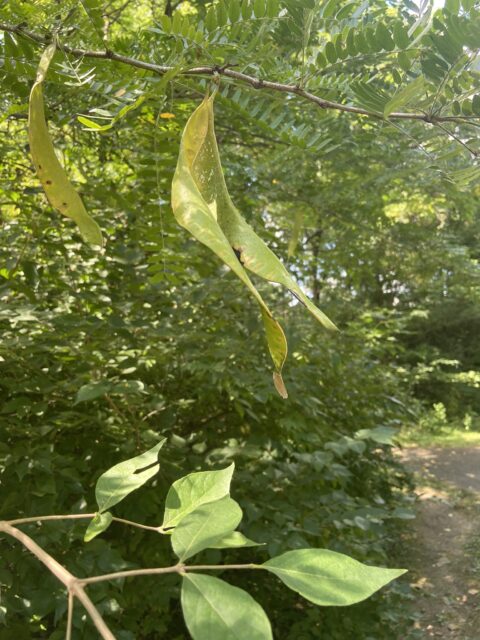
Shown hanging are the long, twisted pods of the tree.
Fun Fact: According to Petrides, the thorns were once used by woodsmen as a means to make spears, pins, and animal traps.
[Tall] Pawpaw
(Asimina triloba)
Before I started treating my tree blindness, I really didn’t consider how much fruit there really was around me aside from the ones I bought at the grocery store. Did you ever think you would find a tree that somehow reminded you of peppers, banana, mango, and pear all at once? Well, neither did I. Enter pawpaw.
I found this tree right along the lowlands along the Olentangy River where the water often floods after large storms. What first caught my attention was the large, half-foot to foot long leaves. They were simple in complexity and alternately arranged like many of the other trees I found, but when I crushed them, I was immediately shocked by the peppery scent that flooded my nostrils. To balance that strong peppery aroma, the trees produced a large fruit that had a much more mild and indescribable flavor. It had the texture and feel of a mango with the slightest hint of banana taste (Or as Petrides described it: “fleshy and somewhat banana like”). Very confusing to my taste buds indeed.
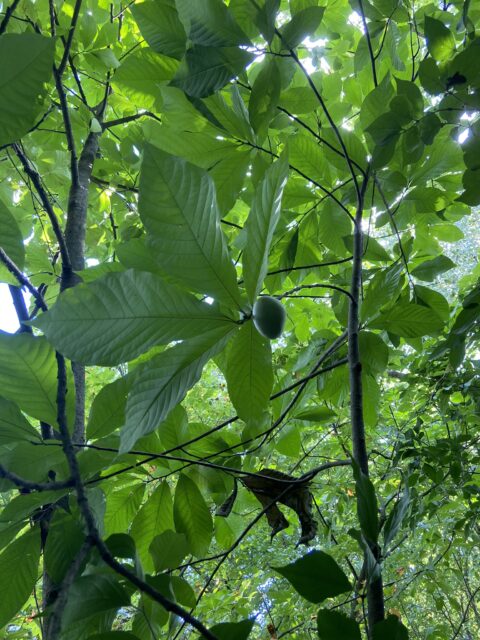
Here are the broad leaves of the pawpaw with one of its ambiguously tasting fruits hanging with them. Those leaves look ginormous in comparison to the rest of the tree.
It may be easy to get lost in the details of this tree because of how big the leaves are compared to the rest of the overall size of the tree. But in order to combat my tree blindness, I took a really close look at the twigs of the tree. What did I discover but a long, bud that was red, long, and hairy. It was very peculiar to me.
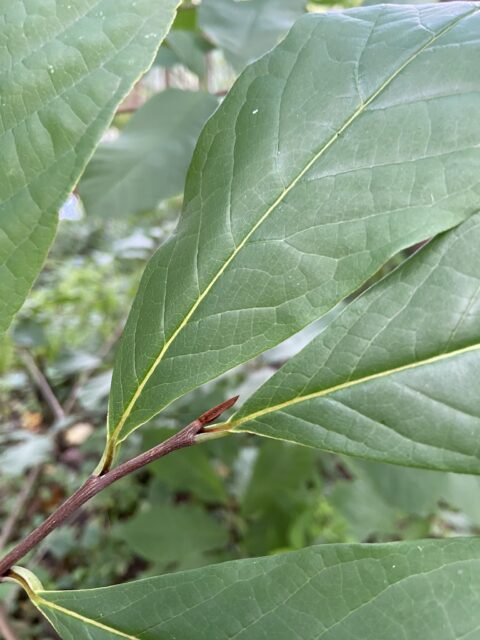
An up close look at the terminal bud of the pawpaw. (Seriously, I cannot emphasize the mere size of these leaves.)
If you are lucky enough to snag a ripened fruit of this tree before an opossum or raccoon, you can try and make them into a refreshing desert. (Anyone craving ice cream now…just me?)
Swamp [White] Oak
(Quercus bicolor)
Before discovering my tree blindness, I was aware of oaks as a concept. I even knew there was a white oak and a red oak. But guess what? There’s even more than that! I almost walked right past this tree when I was venturing through the lowland, poorly drained areas of the Olentangy River wetlands. Like other oaks, it has simple, alternate leaves. The leaves have “rounded teeth” with shallow dips between their lobes compared to the white oak (Quercus alba), which has deep sinuses between the lobes of its leaves.

Looking up at the leaves of the swamp oak.
The bark of the swamp white oak is a light gray color that often appears flaky and can look quite similar to its other white oak relative.
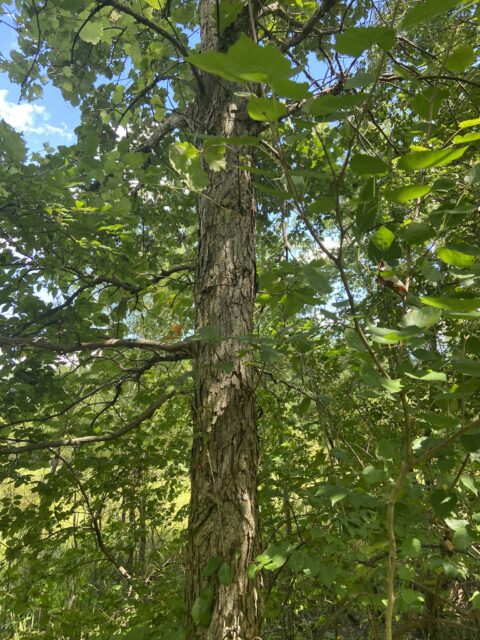
Flaky bark of the swamp white oak.
Despite being a separate species from the white oak, the lumber is not considered a different type of wood (Petrides). Guess sometimes lumber even has tree blindness!
Sycamore
(Platanus occidentalis)
The last tree from my journey along the Olentangy that I will discuss is the sycamore. (There were more trees on the walk, but this page can only go on for so long). The sycamores I saw along the edge of the river were magnificent. Their simple alternate leaves alone may not distinguish them from other trees, but there are plenty of unique characteristics to set this tree apart. When looking at the leaves on the twigs, the base of the leaf stalk closes around the buds and are hollow.
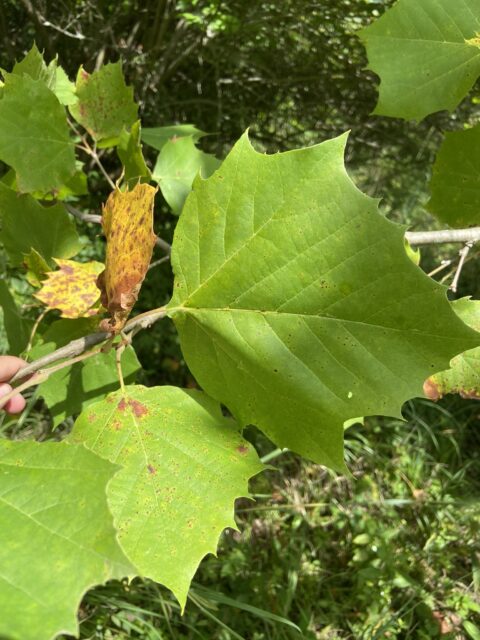
Up-close of a sycamore leaf. Notice the rounded end of the leafstalk where it encloses the bud.
That’s not all! The bark of this tree is unlike any I have seen before. What starts off as a dull, unassuming gray bark, peels back to reveal mottles of yellow and white. It almost looks like nature tried a paint-by-numbers. All of these features together, plus the size that these trees can reach truly make it a work of art.
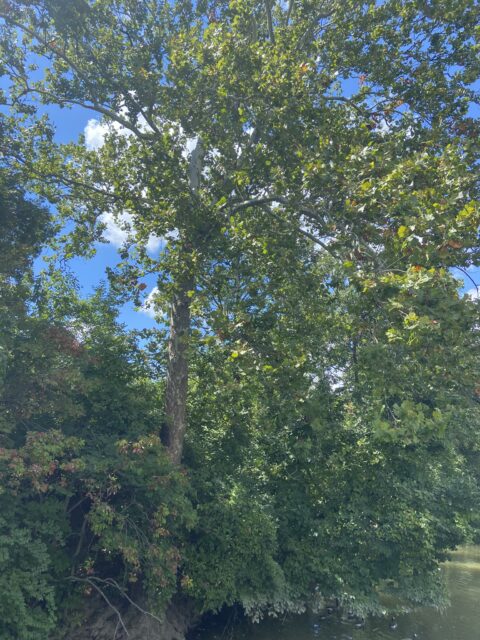
A sycamore towering over the river. You can even see the mottled bark from this far away!
In addition to being a beautiful specimen, the sycamore has many practical uses too! According to Petrides, Native Americans used this wood to make dugout canoes (one even reached a length of 65 ft and a weight of 900 lbs!) The animals love it as well, and you might see a muskrat nibble on its twigs or a wood duck nest in its cavities.
Tree Blind to Tree State of Mind
Whew! What an adventure. Thanks for coming along with me and opening our eyes to the wonderful world of trees. Popkin was right when he said that “not everything in the world is so dismal.” The trees all around us are fascinating both physically and ecologically.
I am by no means an expert in trees now, but I do appreciate them more and feel like I have a better grasp on identifying them. However, none of that would’ve have been possible without Petrides’s field guide and detailed descriptions. So, I would like to reiterate that information and facts presented about the trees–other than my opinions of them– were derived from his 1958 Field Guide to Trees and Shrubs (unless otherwise noted).
